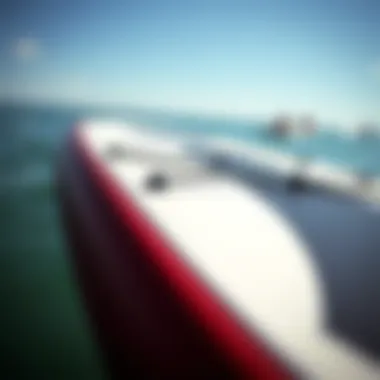Exploring Powered SUP Boards: A Comprehensive Guide


Intro
As paddleboarding continues to surge in popularity, powered stand-up paddleboards (SUPs) are making waves, transforming this age-old activity into something distinctly modern and exhilarating. Whether you're a neophyte or a seasoned veteran, the world of powered SUP boards offers a thrilling, efficient way to navigate waterways effortlessly. But what is it that makes these boards so intriguing? This article aims to peel back the layers on powered SUP boards—examining their design, the technology behind them, and their multifaceted applications.
Expect to explore everything from the essential tech features that give powered boards their edge to practical maintenance tips that will keep your equipment in tip-top shape. Understanding the environmental implications of using powered boards also matters, as we examine how they influence our cherished waters and the cultural impact they have gained in recent years.
Let’s dive into this expansive topic and enrich our understanding of powered SUP boards together!
Surf Gear and Equipment
Powered SUP boards come equipped with a range of innovative technologies designed to boost your paddling experience. If you're considering taking the plunge, knowing what's available can help elevate your adventures on the water.
Latest Surfboard Technologies
When it comes to powered SUPs, technology plays a crucial role. Electric motors, primarily located at the tail, are the heartbeat of these boards, allowing riders to glide effortlessly regardless of skill level. Here's a quick rundown on some key features:
- Power and Control Systems: Most powered boards come with wireless remote controls. This allows you to adjust your speed without missing a beat on your paddle.
- Battery Life: Boards usually utilize high-capacity lithium-ion batteries that can support long rides—often up to several hours—depending on the model.
- Lightweight Materials: With advancements in materials like composite and foam cores, boards have become significantly lighter, making them easier to maneuver while maintaining durability.
These developments don't just offer convenience; they can also amplify safety on the water by providing options to ride with minimal effort, leaving you with more energy for exploration.
Essential Accessories for Surfers
No paddleboard setup is complete without some gear to enhance your experience. Here are a few essential accessories you shouldn't overlook:
- Personal flotation devices (PFDs): Always a must, especially for wider water bodies.
- Leashes: To keep your board close if you suddenly take a tumble.
- Paddle Gear: Adjustable paddles are crucial to finding your perfect fit for comfort and efficiency.
- Storage Solutions: Waterproof bags to keep your essentials safe aboard should you face unexpected splashes or rain.
These accessories not only enhance safety but also provide extra utility for longer excursions.
Techniques and Skills
While the technology behind powered SUP boards streamlines your experience, understanding the techniques associated with them can make your paddling more effective and enjoyable.
Wave Riding Strategies
Although powered SUP boards excel on flat waters, many enthusiasts still seek the adrenaline rush of catching waves. A few tips here could come in handy:
- Positioning: Keep your weight slightly forward to maintain buoyancy as you approach a wave.
- Timing: Paddle hard before reaching a wave to gain momentum.
- Balance: Shift your weight to the back when descending to avoid nosedives.
Mastering these techniques not only enhances your skills but can also open the door to thrilling experiences when riding the surf.
Safety and Surf Etiquette
No matter how skilled you are, practicing good etiquette is essential for yourself and fellow water-goers. Remember these guidelines:
- Respect Right of Way: If others are riding, maintain a safe distance.
- Be Aware of Your Surroundings: Watch for boats, swimmers, and other surfers.
- Stay Calm: If you fall, remain composed, and ensure your board is not a hazard to others.
By adopting these behaviors, you foster a community that values safety alongside the thrill of the sport.
Staying informed and properly equipped ensures that you get the most out of your powered SUP experience while also respecting nature.
As powered SUP boards continue to evolve, indulging in this exciting hobby can lead to many memorable adventures. Dive into this comprehensive guide and enjoy your journey across the waters!
Understanding Powered SUP Boards
Powered stand-up paddleboards (SUPs) embody an exciting shift in water sports, highlighting how technology can enhance traditional activities. Comprehending these boards involves looking beyond their mere existence; it means appreciating the synergy of design and innovation they bring to the water. This understanding becomes especially vital for those who want to maximize their experience—be it smooth gliding across serene lakes or tackling surging waves. Where traditional paddling may demand significant physical effort, powered boards offer simpler navigation, making water adventures accessible to a broader range of enthusiasts.
Definition and Overview
Powered SUP boards are stand-up paddleboards that incorporate a motor, typically electric, allowing users to navigate more easily through water. Instead of consistently paddling, riders can control the board's speed and direction using a handheld remote or foot controls. This augmented capability enlarges the user base; families, casual paddlers, or even those with mobility constraints can enjoy the benefits of paddleboarding without the exertion usually associated with it. The design might vary in size, shape, and capacity, yet the common thread remains the hidden energy beneath.
The boards utilize lightweight materials, allowing for enhanced portability while housing onboard systems that are equally sophisticated and easy to use. Some models even come equipped with features like GPS, Bluetooth speakers, and enhanced LED lights, merging convenience with the thrill of outdoor exploration. While more expensive than traditional boards, many argue that the ease of use and versatility justifies the investment, enabling a unique perspective of nature that traditional paddleboarding might not provide.
Historical Context
The evolution of powered SUP boards traces back to the mid-20th century, where innovation in water sports took initial tiny steps. The concept of adding motors to boards was initially met with a sprinkle of skepticism. Over time, however, enthusiasts began to appreciate the potential blend of adrenaline and leisure. Early prototypes were rudimentary, often clunky, and not particularly user-friendly; yet, they laid the groundwork for what was to come.
In the 2000s, paddleboarding gained traction, aided by fitness trends and the push for outdoor activities. As manufacturers saw the demand rising, they began refining powered boards. The first commercially viable powered SUP surfaced around 2012, marking a significant turning point. This enabled a new hybrid segment within water sports, catering to those seeking leisurely experiences as well as thrill-seekers.
The popularity of powered boards surged further with technological advances in battery life and motor efficiency. Designs evolved to include sturdy yet lightweight materials, leading to sleeker forms that combined performance with usability. Now, the landscape includes various models tailored for different experiences, ensuring users can find a board suited to their specific needs or preferences.
Imagine agility on the water without feeling utterly spent after a few strokes; this is what clarity about powered SUPs brings. As awareness grows and technology matures, these boards are not just seen as gadgets. They stand as embodiments of the freedom to explore waterways without the heavy lifting traditionally associated with paddling.


The Technology Behind Powered SUP Boards
Understanding the technology behind powered stand-up paddleboards (SUPs) is essential for enthusiasts looking to maximize their experience on the water. The integration of electrifying motors, advanced battery systems, and sophisticated control mechanisms transforms a traditional paddleboarding experience into a futuristic aquatic adventure. These technological components are crucial not only for performance but also for safety and enjoyment. Let’s take a closer look at the various elements that contribute to the functionality of powered SUP boards.
Electric Motor Mechanisms
Electric motors are the beating heart of powered SUP boards. They come in a variety of configurations, often determined by the intended use of the board. A brushless motor, for instance, provides a more efficient and quieter operation compared to traditional brushed motors. This means less noise pollution in serene environments, making for a more peaceful paddling experience.
The positioning of the motor can affect the board's stability and handling. Motors located toward the rear offer better maneuverability, while a centrally located motor provides a balanced distribution of weight. Also, the power output varies; boards are typically equipped with motors ranging from 400 to 2000 watts. Higher wattage allows for improved speed and easier navigation through rough waters, catering to both thrill-seekers and leisure paddlers. Understanding these variations helps buyers make informed choices that match their personal preferences and skill levels.
Battery Technology
The battery is another vital component in the equation. Lithium-ion batteries are popular for powered SUPs due to their lightweight characteristics and long-lasting power. Most commonly, battery capacities range between 12Ah to 20Ah, with higher capacities offering longer run times. However, it’s not just about the size; the discharge rate is equally important. A battery with a high discharge rate ensures that the motor receives enough power for performance without running out of juice too soon.
Moreover, the placement and ease of access to the battery are also considerations to keep in mind. In some boards, the battery is built into the design for better aesthetics, while others have accessible compartments for easy swapping during long outings. It's worthwhile for users to think about charging capabilities as well. Some newer boards feature fast-charging options or even solar panel integrations, providing eco-friendly choices for sustainability-minded paddlers.
Control Systems and Navigation
Modern powered SUP boards are increasingly equipped with sophisticated control systems for ease of use. Most boards feature wireless remote controls that allow the rider to manage speed and direction effortlessly, providing an intuitive experience. Some high-end options include cruise control settings that can maintain a constant speed, giving paddlers the ability to focus more on enjoying the scenery around them than on constant adjustments.
Navigation features are also becoming common. Certain boards integrate GPS technology that tracks speed, distance, and location, allowing users to monitor their routes and explore new places with confidence. In some advanced setups, users can even pre-program routes for guided experiences.
As technology evolves, powered SUP boards are becoming more than just recreational equipment; they are transforming into smart watercraft that adapt to the desires and needs of the user.
In summary, the technology behind powered SUP boards encompasses electric motors, battery innovations, and advanced control systems, each playing a crucial role in enhancing the paddling experience. By understanding these technological advancements, paddlers can choose the right equipment tailored to their individual needs, ensuring maximum enjoyment and safety on the water.
Benefits of Using Powered SUP Boards
Powered stand-up paddleboards (SUPs) aren't just a passing fad; they represent a significant shift in how we engage with water sports. The benefits of these boards extend beyond mere convenience, opening up new opportunities and experiences for users. Whether you’re a recreational paddler looking to enjoy the water or a fitness enthusiast aiming to enhance your workout, understanding the myriad advantages is essential.
Enhanced Mobility on Water
One of the most prominent benefits of using powered SUP boards is the enhanced mobility they offer. Unlike traditional paddling methods, which can lead to fatigue over time, powered SUPs provide a propulsion system that allows users to glide effortlessly across various water conditions.
- Speed: The electric motors can boost speed significantly, allowing you to cover more ground in less time. This feature is particularly beneficial in larger bodies of water where paddling distances can be taxing.
- Ease of Use: For novice paddlers or those with limited strength, these boards remove the struggle involved in staying afloat and maneuvering. An electric motor can literally take you from point A to point B with minimal effort.
- Adverse Conditions: Weather can kick up fast on lakes, rivers, or oceans. Powered SUPs let users paddle against stronger winds and currents safely. With the ability to control your speed and momentum, it becomes much easier to navigate these challenges without feeling overwhelmed.
Reducing Physical Strain
With increasing awareness about physical well-being, powered SUP boards emerge as a game-changer for many. The fact that you can enjoy your time on the water without straining yourself is notable.
- Joint Safety: Many individuals might find conventional paddling puts a strain on their knees or back. A powered SUP allows you to enjoy the water while minimizing high-impact stress. This is especially important for those recovering from injuries or with chronic pain.
- Sustained Activity: Because they don’t require the same physical exertion, powered SUP boards enable users to remain active for longer periods. This leads to an enriched experience, allowing for further exploration without the weariness that generally accompanies long paddle sessions.
- Versatile Workouts: For fitness enthusiasts, having a powered SUP board means that you can enjoy both a calming pace or opt for an intense cardio workout depending on your mood or environment. Switch modes as you like—this flexibility is invaluable.
Accessing Remote Locations
Lastly, powered SUP boards offer the unique advantage of accessing remote locations that might normally be too challenging to reach.
- Exploration: There are countless hidden gems along waterways that are often out of reach for traditional paddlers. With a powered SUP, discovering these secluded spots becomes less daunting and more attainable.
- Fishing and Nature Watching: Anglers and wildlife enthusiasts will find that these boards facilitate access to quieter waters and prime areas where fish or wildlife gather. This becomes especially useful for spotting that elusive catch or observing nature in its element without disturbing the ecosystem.
- Adventure Opportunities: Remote river bends, coastal nooks, or sprawling lakes double as avenues for adventure. Users can enjoy spontaneous day trips and create new memories—all made possible by the mobility that powered SUPs provide.
Selecting the Right Powered SUP Board
Choosing the right powered stand-up paddleboard (SUP) can feel like finding a needle in a haystack, given the plethora of options available on the market today. The right board can elevate your experience, providing comfort, performance, and access to those tricky, off-the-beaten-path spots you’ve always wanted to explore. It's not just about what looks good; understanding specific elements, benefits, and considerations is key in making an informed decision that matches your unique needs.
Size and Weight Considerations
The size and weight of the powered SUP board are crucial aspects to consider. A board that fits your physical stature increases stability and maximizes control on the water. Boards typically range from 10 to 14 feet in length. For example, a 10-foot board might be perfect for casual lakes, while a longer board is better suited for ocean waves.
When selecting a board, pay attention to the width, which generally influences stability. Wider boards, around 32 inches or more, are excellent for beginners and those preferring leisurely rides. However, a narrower board, while less stable, can provide improved speed and efficiency especially for skilled paddlers.
Weight also plays an important role. If you're planning to carry it to various locations, consider models that weigh less than 30 pounds. The materials used, often a blend of foam and fiberglass, can greatly impact the weight of the board.
Performance Features to Look For
Performance features can make or break your paddling experience. Essential components include the motor power, which is usually measured in watts. A motor between 600 to 1,000 watts will give you enough thrust to navigate roughly all water conditions.
Another feature to check is the speed settings. Some boards allow you to adjust the speed, which can be a game changer, especially when tackling waves or strong winds. This versatility not only amplifies fun but also enhances safety by giving you better control in challenging conditions.
Inspect the fin configuration too. Different setups show varying effects on performance; three fins are typical for stability, whereas a single fin can provide speed and agility. Look for adjustable fins as they permit customization based on water conditions.
Brand Comparisons
When it comes to selecting powered SUP boards, certain brands have carved a niche for themselves. For instance, Aqua Marina offers budget-friendly models without sacrificing quality, catering well to newcomers in the SUP world.
On the premium side, Red Paddle Co is known for their innovation and durability. Their boards are often lightweight yet robust, appealing to both casual paddlers and serious enthusiasts.


Bic Sport, another noteworthy mention, is recognized for their versatile boards which are great for a variety of water conditions. Comparing these brands means looking beyond mere price; factors like customer service, warranty, and user reviews should also play a pivotal role in your selection.
"The journey of a thousand miles begins with a single step, or in this case, a single paddle!"
For further reading on sizing and performance, visit Wikipedia and traveler experiences on platforms like Reddit.
Safety Considerations
When partaking in the exhilarating world of powered stand-up paddleboarding, prioritizing safety cannot be overstressed. The blend of water, technology, and recreation presents particular challenges that need to be navigated with care. It’s not merely about enjoying the ride; safety considerations encompass planning, preparation, and understanding environmental conditions to ensure a rewarding experience.
Wearable Safety Gear
Equipping oneself with appropriate wearable safety gear is essential when utilizing powered SUP boards. Life jackets, often overlooked, should be a non-negotiable item on your checklist. They come in various forms, from standard buoyancy aids to more advanced inflatable types, which take less space and allow for movement. Cold water immersion suits are another consideration, especially in chillier climates, as they provide crucial insulation should one find themselves in the water unexpectedly.
Other personal items worth contemplating include:
- Leash: A sup leash keeps you connected to your board. If you fall off, this vital piece of equipment helps you retrieve your board swiftly.
- Helmet: Although rarely worn by paddleboarders, if you’re cruising in unpredictable waters or surfing small waves, helmets can add an extra layer of protection.
- Sunglasses with Croakies: Protect your eyes from harmful UV rays while ensuring they don’t get lost in the water. These handy accessories keep everything in check.
Understanding Water Conditions
Navigating the nuances of water conditions is crucial for a safe and enjoyable experience. This knowledge combines both observation and research, as no two days on the water are alike. Recognizing the difference between calm and turbulent waters can mean the difference between a day filled with enjoyment or one marked by worry.
Key aspects to keep in mind include:
- Wind Directions and Speeds: Strong winds can quickly lead to challenging scenarios, particularly for novices. Familiarize yourself with wind patterns before heading out.
- Current and Tides: The movement of the water can significantly affect paddling difficulty. A strong current can lead you farther from shore than anticipated.
- Weather Patterns: Always check forecasts. Sudden storms may arise, often catching unprepared paddlers off guard.
"Knowledge is power, especially when it comes to safety on the water."
Equipment Failures and Emergency Protocols
Even the best-maintained powered SUP boards can encounter unexpected mechanical failures. Thus, taking a proactive approach towards understanding potential issues is paramount. Here’s where preparedness steps in. Knowing how to respond when things go awry can help avert disasters.
- Pre-Departure Checklist: Develop a habit of conducting routine inspections. Examine battery levels, motor functionality, and any physical damage before every paddle.
- Emergency Protocols: Familiarize yourself with procedures to follow in case of equipment failure. Carry a whistle or personal locator beacon, which can be a lifesaver when you’re in distress.
- Keep a Mobile Phone Handy: If it falls into the water, use a waterproof pouch or dry bag to keep it secure. Emergency contacts and local authorities should always be easily reachable in case of an urgent situation.
By integrating these safety considerations into your paddleboarding excursions, you allow yourself to fully embrace the joys of this activity without putting yourself or others at risk. Awareness and preparation go hand in hand; these guiding principles not only enhance your recreational experience but contribute to the overall safety culture within the sport.
For more information on paddleboarding safety, resources can be found at Reddit and U.S. Coast Guard Guidelines.
As the popularity of powered SUP boards rises, so does the responsibility to uphold safety as a theme within the community.
Maintaining Your Powered SUP Board
Proper maintenance of your powered stand-up paddleboard is key to ensuring longevity, performance, and safety on the water. Neglecting this aspect can lead not only to diminished fun but can also increase risks during adventures. Just like a fine car needs regular tune-ups to perform at its best, your SUP deserves the same level of attention. Keeping your board in tip-top shape enhances the overall experience, allowing paddlers to fully enjoy the thrill of gliding across serene lakes or challenging coastal waves.
Regular Inspection Checklists
Inspecting your powered SUP board regularly is crucial. A good habit is to create a checklist that can be easily followed. Here are some key points to consider:
- Visual Inspection: Look for cracks, chips, or any visible damage on the body of the board.
- Fin Condition: Ensure that the fins are securely attached and not damaged.
- Electrical Components: Check for any frayed wires or discrepancies in the lighting and motor functions.
- Battery Connection: Inspect the battery terminals for corrosion or dirt buildup, as these can hinder performance.
By following this routine, any potential issues can be caught early, potentially saving money and hassle later on.
Cleaning and Storage Techniques
Caring for your board goes beyond inspections; regular cleaning and proper storage extend the life of your SUP. Here are a few pointers to keep in mind:
- After Every Use: Rinse the board with fresh water to remove salt, algae, or debris that can cause corrosion or deterioration.
- Cleaning Products: Use mild soap and a non-abrasive cloth for cleaning. Products made specifically for marine environments may work well.
- Drying: Always let the board dry completely before storing it. Water trapped in crevices can lead to mold or mildew.
- Storage Location: Store your board in a cool, shaded area, away from direct sunlight. Exposure can warp the board and affect its integrity over time.
Adhering to these cleaning and storage practices ensures that your board remains as vibrant as the day it was purchased.
Battery Maintenance Best Practices
The heart of a powered SUP lies in its battery. Proper care can significantly improve its performance and lifespan. Here’s how to maintain your battery:
- Charging Routine: Avoid overcharging or completely draining the battery. Aim to keep it between 20% and 80% for optimal health.
- Temperature Awareness: Store the battery at moderate temperatures. Extreme heat or cold can lead to irreversible damage.
- Regular Checks: Monitor the battery's health, ensuring connections are tight and free from corrosion.
- Replacement Awareness: Know the typical lifespan of your battery model, planning replacements in advance to avoid unexpected failures.
With diligent attention to these maintenance tips, your powered SUP board will be well-equipped to provide endless adventures on the water.
Environmental Impact of Powered SUP Boards
The rise of powered stand-up paddleboards (SUPs) brings forth a critical conversation around their environmental impact. Navigating this topic ensures that enthusiasts not only enjoy the thrill of riding the waves but also consider the ecological consequences of their pursuits. It's essential to weigh the benefits of powered boards against potential risks to ecosystems and waterways. As more people consider incorporating powered SUPs into their adventures, understanding their environmental implications is crucial.
One of the core concerns is the potential for pollution, primarily from the electric motors. Although these motors emit less noise and air pollution compared to their gasoline counterparts, they may still have a footprint, especially concerning battery life and disposal. The battery technology, while advancing, can pose a risk if not properly managed. Batteries can leak harmful chemicals into the environment if they reach the end of their life cycle without being recycled properly. This is where sustainable practices play a significant role in mitigating negative effects.


Sustainable Practices
Implementing sustainable practices can significantly reduce the environmental footprint of powered SUP boards. Here are some actionable strategies that enthusiasts should consider:
- Opt for Eco-Friendly Batteries: Use lithium-ion batteries with a proven track record of recyclability. Companies are increasingly focusing on sustainability, and some newer models even employ biodegradable materials.
- Responsible Recreation: Paddleboarders should choose locations that can support their activities without harming fragile ecosystems. Avoiding sensitive habitats like mangroves or coral reefs is a must.
- Education and Advocacy: Inform fellow riders about eco-friendly practices. Being a part of community discussions and advocacy can lead to better compliance with environmental regulations.
- Regular Cleaning: Keeping boards clean prevents the spread of contaminants. Always rinse your SUP in freshwater after use to eliminate salt, dirt, and possibly harmful substances.
Implementing these practices helps ensure that the beauty of waterways remains intact for future generations to enjoy.
Comparing Environmental Footprints
When it comes to assessing the environmental impact of powered SUP boards, comparing their footprints to traditional, non-motorized boards can yield interesting insights. Traditional paddles are typically viewed as more environmentally benign. However, powered boards often enable users to reach remote locations that would otherwise be too strenuous to paddle toward. In this vein, the following points provide a clearer picture:
- Energy Efficiency: Though powered boards utilize electric motors, they often consume less energy in reaching destinations compared to the cumulative exertion required for prolonged paddling.
- Carbon Footprint: Depending on how the electricity is sourced, powered SUPs may have a lower carbon footprint than expected, especially if charging takes place via renewable energy. It's a misconception that electric means harmful to the environment.
- Access to Off-the-Beaten-Path Nature: Having the ability to access more pristine environments cuts down on congestion in popular tourist spots, potentially leading to less wear and tear on some areas.
- Life Cycle Assessment: Evaluating the entire life cycle of powered SUPs, from production to disposal, gives a fuller understanding of their environmental impacts. Conducting life cycle assessments (LCA) can guide manufacturers in making more sustainable choices.
Cultural Perspectives on Powered SUP Boarding
The world of powered stand-up paddleboarding (SUP) extends far beyond just the mechanical marvels resting on the water's surface; it embodies a rich tapestry of culture, community, and connection to nature. Understanding this cultural perspective is crucial not just for enthusiasts but also for anyone looking to engage deeply with this sport. It rings true that a sport can serve as a mirror for societal attitudes, values, and even local traditions.
The Evolution of SUP Culture
In the early days, stand-up paddleboarding originated from Hawaiian surf culture, where experienced surfers used wooden boards and paddles to navigate the waves. From there, it made its way into mainstream water sports, slowly evolving into a myriad of styles and purposes. As powered boards emerged, this traditional art began to shift. People weren't just riding for sport or leisure anymore; they were navigating coastal waters, exploring hidden lagoons, and jettisoning the limitations posed by physical stamina.
The advent of powered SUP boards marked a significant cultural shift. It opened up paddleboarding to individuals with varying abilities and ages. Imagine a 60-year-old first-time paddleboarder gliding effortlessly past seasoned surfers; this is what technological advancement has afforded us. The SUP culture has diversified, welcoming a broader demographic while retaining true to its oceanic roots. Moreover, local culture plays a vital role in how powered SUP boards are perceived and utilized. In regions where agriculture or fishing thrives, these boards have been adopted for practical usage, serving as tools for farmers and fishermen alike. This integration of technology into daily life highlights how culture evolves around practical needs, converging modernity with tradition.
Community and Events
The camaraderie among enthusiasts forms the backbone of powered SUP culture. Community gatherings, organized events, and competitions are commonplace. Think of the local beach where groups gather every Sunday to share tips and swap stories over their favorite boards. Events such as the Willamette River Clean Up, where paddleboarders assist in cleaning polluted waterways, exemplify how culture can galvanize a community not just around a sport but also around environmental stewardship.
"Paddleboarding isn't just about gliding across water; it’s about coexistence with nature, the culture of caring for our environment, and fostering connections among people."
As interest in powered SUP continues to gain traction, more events are cropping up, including festivals and races that feature both traditional and powered boards. These events often embody cultural significance, celebrating local heritage while fostering competition. Participants can win awards, but the real prize lies in community spirit and togetherness. Social media also plays a pivotal role in bringing enthusiasts closer. Platforms like Facebook and Reddit provide forums for sharing experiences, where stories of epic outings or humble beginnings can inspire newcomers and veterans alike.
In encapsulating the cultural perspectives on powered SUP boarding, it becomes evident that this sport represents much more than just a leisure activity. It reveals values tied to adventure, inclusivity, and a collective effort to harmonize with the natural world.
Future Trends in Powered SUP Technology
The landscape of powered stand-up paddleboards is rapidly changing, influenced by emerging technologies and shifting user preferences. Understanding the future trends in powered SUP technology not only prepares enthusiasts for what lies ahead but also helps in optimizing their experience on the water. This section dives into innovations that are set to reshape how we approach paddleboarding, as well as the evolving demographics of the user base.
Innovations on the Horizon
As technology continues to advance, certain innovative features are coming to light that promise to enhance the powered SUP experience significantly. One of these innovations is the integration of smart technology. Imagine a paddleboard equipped with sensors that can analyze water conditions, optimize speed, and even suggest routes based on user preferences. This level of connectivity and intelligence allows for a safer and more enjoyable ride.
Another noteworthy innovation is the development of lightweight and more efficient battery systems. Current industry leaders are exploring the possibility of lithium-sulfur batteries, which have the potential to offer greater energy density compared to traditional lithium-ion batteries. This means powered SUP boards could become lighter and offer longer usage time without sacrificing performance.
Furthermore, the introduction of modular designs in powered SUP boards is gaining traction. This feature allows users to customize various components, such as motors and battery packs, providing flexibility and optimizing performance according to personal needs or environmental conditions. With each power adapt, users can either power through waves or glide leisurely across flat waters.
"The development of smart paddleboards is set to offer not just an enjoyable ride but also peace of mind, making every outing more enjoyable and less stressful for users."
Changing User Demographics
The demographic landscape of powered SUP enthusiasts is evolving. Traditionally, paddleboarding attracted outdoor enthusiasts and fitness lovers. However, the advent of powered boards is enticing a broader audience. From urban dwellers seeking relaxation on weekends to families looking for kid-friendly water sports, the user base is diversifying.
Additionally, as environmental awareness grows, many paddlers are actively seeking sustainable options. This shift encourages manufacturers to integrate eco-friendly materials and practices in their products. Businesses are focusing on creating boards that can cater not only to diverse recreational needs but also to promote sustainability in paddleboarding.
Younger generations are also stepping into this arena. Millennials and Gen Z are drawn to the tech-savvy nature of powered boards that connect to smartphone apps for tracking performance or finding suitable water bodies to explore. This embraces a blend of adventure with modern technology, appealing to their lifestyles.
Overall, the future of powered SUP technology is bright. With innovations on the brink of becoming mainstream and a shifting user demographic, more people will engage with the waterways, enjoying the newfound freedom and accessibility that powered boards offer.
Personal Stories and Testimonials
Personal stories and testimonials are not just anecdotes; they're a tapestry that weaves together the experiences of powered stand-up paddleboard (SUP) enthusiasts. This section highlights voices that resonate with both the challenges and triumps of those who have embraced the powered SUP lifestyle. By sharing personal narratives, readers can relate to others on similar journeys, fostering a sense of community and connection.
These stories provide insights that data alone cannot capture. They capture emotions, thoughts, and the unique nuances of paddling experiences that statistics simply typify over. This authenticity allows potential users to envision themselves cruising along serene water surfaces, or tackling challenging currents with a powered SUP board. Each story serves a purpose; it offers reassurance, inspires adaptability, and provides a glimpse of the vast adventurous possibilities awaiting a curious paddler.
Interview with Enthusiasts
Interviews with enthusiasts shine a light on the personal aspects that make powered SUP boarding appealing. Many people, like Tom from Florida, share how their paddleboarding became a vital part of their routine. Tom narrates his experience, stating, "After long days at work, the water serves as my escape. With powered SUPs, I can glide effortlessly across the bay, leaving the stress behind."
Enthusiasts often express their connection to nature through powered SUP technology. Kayla, an avid paddler from California, explains, "I love feeling the power beneath my feet as I navigate through waves or drift along the coast. It’s a beautiful blend of technology and nature, keeping the spirit of adventure alive."
Through such narratives, insights emerge about how powered SUP boards have transformed their leisure and fitness activities. Whether it's a new hobby or an evolved lifestyle, these interviews showcase the diverse ways SUP enthusiasts incorporate their boards into daily life.
Unique Experiences on the Water
Unique experiences shared by individuals enrich our understanding of powered SUPs. Every paddler has stories that reveal the places they’ve visited and the challenges they've overcome. Many memorable moments occur while exploring secluded coves or encountering wildlife, which provides ponder-worthy reflections. For instance, one paddler recounts an unexpected encounter with dolphins off the coast of Maui, describing it as a once-in-a-lifetime experience that solidified his love for the sport.
Others might emphasize how powered SUP boards enabled them to reach areas impossible by traditional means. The thrill of discovering hidden lagoons or pristine beaches adds a layer of excitement and joy. These recollections not only serve to inform but also inspire those interested in powered SUP boarding, inviting them to dream of their own adventures that await.
Sharing unique water experiences creates a sense of wonder. Enthusiasts often see their boards as a gateway to explore nature in ways that are extraordinary and invigorating.















